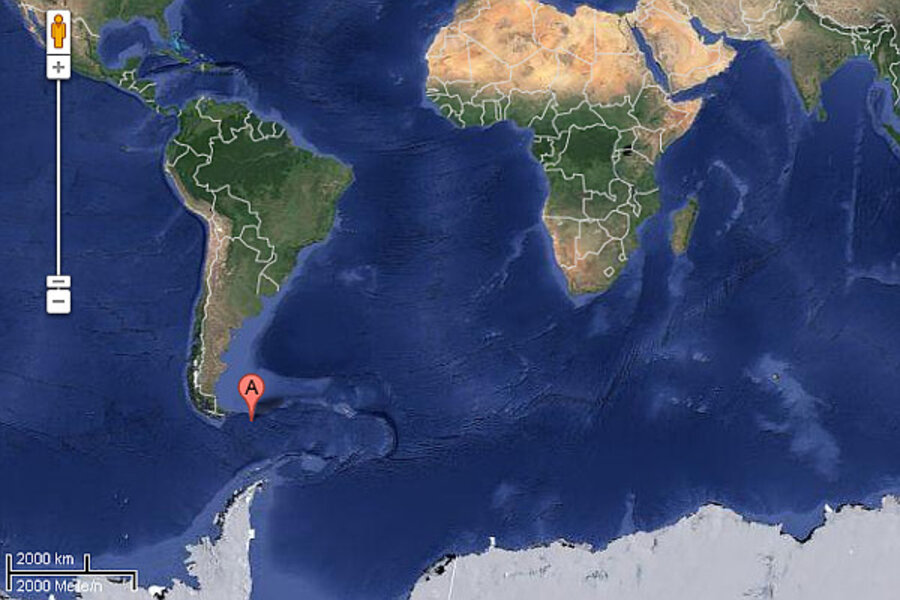Splashdown! Falling GOCE satellite lands in the Atlantic
Loading...
After fighting a losing battle against gravity, the European Space Agency's GOCE satellite has made splashdown somewhere in the south Atlantic Ocean, says the ESA. Its final orbit flew over Siberia, the western Pacific Ocean, the eastern Indian Ocean, and Antarctica before entering the atmosphere a few hundred miles south of the Falkland Islands.
As expected, the 2,500-pound satellite broke apart when it reentered the atmosphere, about 80 miles above Earth's surface. The ESA estimates that three-fourths of the satellite burned up during reentry, leaving some 600 pounds of material, probably broken into several dozen pieces, to splash into the Atlantic.
An ocean splashdown was always most likely, as 70 percent of Earth's surface is covered in water.
GOCE reentered the atmosphere no later than 7:16 p.m. Eastern time, Sunday evening, say officials with the US Space Control and Space Surveillance (SCSS). GOCE debris therefore would have fallen into the southernmost regions of the Atlantic Ocean, reports Daniel Scuka, senior editor for spacecraft operations at ESA's European Space Operations Centre in Darmstadt, Germany.
GOCE, the Gravity field and Ocean Circulation Explorer, was launched in March 2009 to map Earth's gravity, in hopes of better understanding ocean currents and the Earth's interior. In order to detect subtle changes in Earth's gravitational field, GOCE had a very low orbit – so low that it felt drag from the edge of Earth's atmosphere, known as the exosphere. To achieve a smooth flight, GOCE used an electric ion propulsion system, pushing electrically charged xenon out the "back" of the satellite to create a gentle forward thrust.
The mission ended Oct. 21, when the satellite had too little xenon gas to continue its propulsion system. It ran completely out of xenon three days later, on Oct. 24. The satellite fell first slowly, then more and more quickly, from a descent of about 1 mile per day at first, to more than 1 mile per hour on its last day in space, ultimately making splashdown at terminal velocity, about 200 m.p.h.
GOCE lasted almost three times as long as expected: Despite an original mission timeline of 20 months, GOCE flew about 4.5 years. Both sturdy and sleek, the satellite known as the "Ferrari of space" stayed strong to the end, holding together through reentry much longer than scientists had anticipated, even as its central computer temperature rose to more than 170 degrees Fahrenheit. The reentry data gathered by ground-based scientists will be invaluable in helping scientists predict future space debris descents.
GOCE was just one of the more than 3,000 satellites in orbit, of which about 1,000 are still operational, according to the ESA. SCSS tracks more than 22,000 large space objects, and NASA is aware of millions of small objects. When their orbits decay, they fall toward Earth. Some 100 to 150 tons of space junk fall into the atmosphere each year, according to Heiner Klinkrad, the head of ESA's Space Debris Office. Most debris burns up in the atmosphere or lands unnoticed, ESA Space Debris Office deputy head Holger Krag told the Associated Press. On average, "roughly every week you have a reentry like GOCE," he says.
One of the best-known reentries is NASA's Skylab space station, which fell from orbit in 1979. About 82 tons of material hit the Earth, some landing in Australia and the rest falling into the Indian Ocean. In 2001, fragments of Russia's 150-ton Mir space station came down in a controlled dive into the Pacific Ocean. More recently, in 2011, NASA's UARS satellite crashed into the Pacific and Germany's ROSAT satellite landed in the Bay of Bengal.
When a satellite falls, space debris can be spread over hundreds of miles. Dr. Krag noted that fragments from a satellite came down in 2011 over the Netherlands, Germany, and the Czech Republic, but no pieces were ever found.
No known human injuries or significant property damage have been caused by falling space junk, according to NASA, but there have been some destructive collisions in space – though none as dramatic as presented in the movie "Gravity." In 1996, a French satellite was damaged by debris from a French rocket that had exploded a decade earlier. In 2009, a defunct Russian satellite smashed into a commercial satellite, single-handedly adding more than 2,000 pieces of trackable debris to Earth's orbit.
Material from the Associated Press was used in this article.








